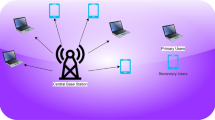Abstract
In this paper, we study topology control and routing issues in mobile cognitive radio networks and propose local cognitive topology control algorithm (LCTCA) to provide the optimal network topology for routing. LCTCA combines link availability with link power consumption to form a multiobjective metric of network topology and routing optimization. The link availability prediction is aware of the interference from secondary users to primary users, the spectrum utilization of primary users, the mobility of secondary users and primary users. Based on the link availability and the power consumption, LCTCA captures the dynamic changes of the topology and constructs a reliable topology under the conditions of network connectivity, which is aimed at selecting the optimal network path and mitigating frequently rerouting. We further analyze the effect of power consumption and link stability on cognitive radio network path selection. Simulation investigation is also provided to verify the theoretical analysis. It shows that the link power consumption and the link stability are both important when selecting the network path.







Similar content being viewed by others
References
Floriano, D. R., Francesca, G., Salvatore, M., & Emilia, B. (2006). A multiobjective approach for energy consumption and link stability issues in ad hoc networks. IEEE Communications Letters, 10(1), 28–30.
Gaurav, S., Vijay, L., Gaur, M. S., & Vijay, R. (2016). Moralism: Mobility prediction with link stability based multicast routing protocol in MANETs. Wireless Network,. doi:10.1007/s11276-015-1186-7.
Guan, Q. S., Yu, F. R., Jiang, S. M., & Wei, G. (2010). Prediction-based topology control and routing in cognitive radio mobile ad hoc networks. IEEE Transactions on Vehicular Technology, 59(9), 4443–4452.
Haykin, S. (2005). Cognitive radio: Brain-empowered wireless communications. IEEE Journal on Selected Areas in Communications, 23(2), 201–220.
Huang, X. L., Wang, G., Hu, F., & Kumar, S. (2011). Stability–capacity–adaptive routing for high-mobility multihop cognitive radio networks. IEEE Transactions on Vehicular Technology, 60(6), 2714–2729.
Javad, V., Prasad, R. V., Ertan, O., & Ignas, N. (2011). Energy-aware routing algorithms for wireless ad hoc networks with heterogeneous power supplies. Computer Networks, 55, 3256–3274.
Javad, V., Prasad, R. V., & Ignas, N. (2012). On the lifetime of node-to-node communication in wireless ad hoc networks. Computer Networks, 56, 1685–1709.
Javad, A., Torkestani, M., & Reza, M. (2011). A link stability-based multicast routing protocol for wireless mobile ad hoc networks. Journal of Network and Computer Applications, 34, 1429–1440.
Jiang, S. M., He, D. J., & Rao, J. Q. (2005). A prediction-based link availability estimation for routing metrics in MANETs. IEEE/ACM Transactions on Networking, 13(6), 1302–1312.
Kanchan, H. W., &Sunita, B. (2014). Link prediction-based topology control and adaptive routing in cognitive radio mobile ad-hoc networks. In IEEE global conference on wireless computing and networking, (pp. 11–15).
Komali, R. S., Thomas, R. W., DaSilva, L. A., & MacKenzie, A. B. (2010). The price of ignorance: Distributed topology control in cognitive networks. IEEE Transactions on Wireless Communications, 9(4), 1434–1445.
Le, D., & Beongku, A. (2016). A modeling framework for supporting and evaluating connectivity in cognitive radio ad hoc networks with beamforming. Wireless Network,. doi:10.1007/s11276-016-1252-9.
Lei, L., Wang, D., Zhou, L., Chen, X. M., & Cai, S. S. (2014). Link availability estimation based reliable routing for aeronautical ad hoc networks. Ad Hoc Networks, 20, 53–63.
Marco, M., Giorgio Q., & Michele, Z. (2014). On the effects of cognitive mobility prediction in wireless multi-hop ad hoc networks. In IEEE ICC 2014—Cognitive radio and networks symposium, (pp. 1638–1644).
Matteo, C., Francesca, C. M., & Eylem, E. (2011). Routing in cognitive radio networks: Challenges and solutions. Ad Hoc Networks, 9, 228–248.
Oliveira, R., Luís, M., Furtado, A., Bernardo, L., Dinis, R., & Pinto, P. (2013). Improving path duration in high mobility vehicular ad hoc networks. Ad Hoc Networks, 11, 89–103.
Petri, M., Marina, P., & Janne, R. (2007). Applications of topology information for cognitive radios and networks. In The 2nd IEEE international symposium on new frontiers in dynamic spectrum access networks, (pp. 103–114).
Ram, N. Y., & Rajiv, M. (2016). k-Channel connected topology control algorithm for cognitive radio networks. In The 8th international conference on communication systems and networks (COMSNETS), (pp. 1–8).
Rappaport, T. S. (2002). Wireless communications: Principles and practice (2nd ed.). Upper Saddle River: Prentice Hall PTR.
Sajjad, Z., Nasser, Y., & Amir, N. (2012). Energy-efficient topology control in wireless ad hoc networks with selfish nodes. Computer Networks, 56, 902–914.
Venkatesan, K. J. P., & Vijayarangan, V. (2016). Secure and reliable routing in cognitive radio networks. Wireless Network,. doi:10.1007/s11276-016-1212-4.
West, D. B. (2004). Introduction to graph theory (2nd ed.). Beijing: China Machine Press.
Wu, J., & Dai, F. (2006). Mobility-sensitive topology control in mobile ad hoc networks. IEEE Transactions on Parallel and Distributed Systems, 17(6), 522–535.
Xiang, Y., Wu, Y., & Peng, J. (2014). A kind of topology control algorithm aimed at extending the life cycle of the WSN. In Proceedings of IEEE on cognitive informatics and cognitive computing (pp. 386–391).
Zhai, D. S., Wang, X. J., Sheng, M., & Zhang, Y. (2014). Bi-channel-connected topology control in cognitive radio networks. In IEEE vehicular technology conference, (pp. 1–5).
Zhao, J., & Cao, G. H. (2014). Robust topology control in multi-hop cognitive radio networks. IEEE Transactions on Mobile Computing, 13(11), 2634–2647.
Acknowledgments
The work described in this paper is supported by National Natural Science Foundation of China under Grants Nos. 61172056, 61201215, and 61201213.
Author information
Authors and Affiliations
Corresponding author
Rights and permissions
About this article
Cite this article
Liu, S., Wang, Y. & Cui, C. A Topology Control and Routing Method in MCRNs Based on Power Consumption and Link Stability. Wireless Pers Commun 92, 1347–1363 (2017). https://doi.org/10.1007/s11277-016-3609-x
Published:
Issue Date:
DOI: https://doi.org/10.1007/s11277-016-3609-x




